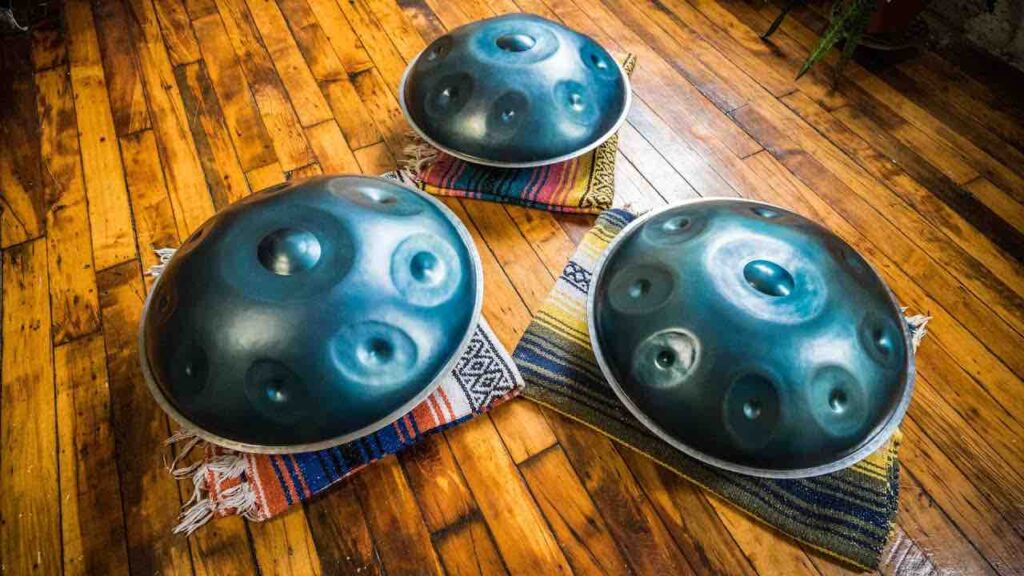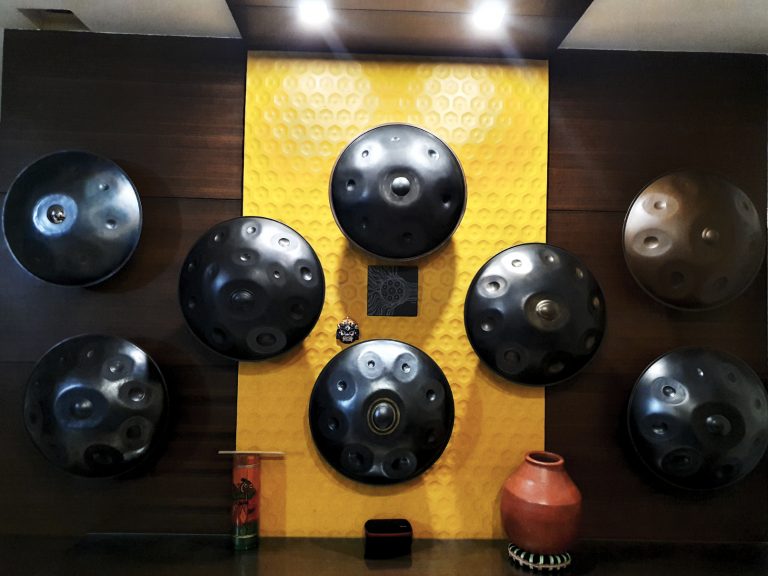Handpans are made by selecting high-quality steel sheets, shaping them into a bowl, adding a protective layer, tuning the surface to create specific notes, and finishing the instrument with decorative touches and a protective coating. The process is highly specialized and requires a great deal of skill and patience.
Step 1: Selection of materials
The first step in making a handpan is selecting the appropriate materials. The most commonly used material is a high-quality steel sheet that is approximately 1 mm thick. This steel sheet is carefully selected for its acoustic properties and its ability to produce the desired sound. The steel sheet is then cut into a circular shape and shaped into a bowl using hydraulic presses. The bowl is then carefully hammered into shape, ensuring that the surface is even and free of any dents or imperfections.

The next step is to add a protective layer to the surface of the handpan. This is typically done using a process known as nitriding, which involves heating the surface of the steel to a high temperature in the presence of nitrogen gas. This creates a hard outer layer that protects the steel from corrosion and damage.
Step 2: Tuning the handpan
Once the protective layer has been applied, the handpan is ready to be tuned. Tuning a handpan is a highly specialized and skilled process that requires a great deal of patience and attention to detail. The tuning process involves carefully hammering specific areas of the surface to create different notes and harmonics. Each handpan is tuned to a specific scale or set of notes, and the tuning process can take anywhere from a few days to several weeks to complete.
During the tuning process, the handpan is tested regularly to ensure that the notes are in tune and that the overall sound is balanced and harmonious. Any adjustments or modifications that are needed are made by carefully hammering the surface in the appropriate areas.
Step 3: Finishing the handpan
Once the tuning process is complete, the handpan is ready to be finished. This involves smoothing out any rough edges or imperfections in the surface and adding any final decorative touches. Many handpan makers choose to add intricate designs or patterns to the surface of the handpan, which are often inspired by nature or spiritual symbols.

The final step in the process is to add a protective coating to the surface of the handpan. This is typically done using a high-quality wax or oil that helps to protect the steel from rust and corrosion. The protective coating also helps to enhance the sound of the handpan, making it more resonant and vibrant.
Where are handpans made?
Handpans are made all over the world, with some of the most well-known makers located in Europe, the United States, and Asia. Each maker has their unique style, and handpans can vary in sound and appearance depending on where they are made.
How long does it take to build a handpan?
The time it takes to build a handpan can vary depending on the maker’s skill level, the complexity of the design, and the number of instruments being produced. On average, it can take several weeks to several months to complete a single handpan. This is due to the highly specialized process of tuning the instrument, which requires a great deal of patience and attention to detail.
How much does it cost to make a handpan?
The cost of making a handpan can vary depending on the materials used, the maker’s experience and reputation, and the complexity of the design. On average, the cost of making a handpan can range from several hundred dollars to several thousand dollars.
This is due to the high cost of materials, such as high-quality steel sheets and protective coatings, as well as the specialized skills and expertise required to produce a high-quality instrument.
Why is the Handpan so expensive?
The Handpan’s high price is due to several factors:
- Firstly, the materials used in making the instrument are expensive, such as the high-quality steel sheets and protective coatings. Additionally, the process of making a handpan is highly specialized and requires a great deal of skill and experience, which commands a higher price.
- Lastly, handpans are in high demand, and many makers have waiting lists of several months or even years, which drives up the price. Overall, the handpan’s high cost reflects the instrument’s unique sound and the amount of time and skill required to produce a high-quality instrument.
FAQs
What kind of steel is used to make handpans?
The steel used to make handpans is typically a high-quality, low-carbon steel that is specifically chosen for its acoustic properties and its ability to produce the desired sound.
How long does it take to make a handpan?
The process of making a handpan can take anywhere from several days to several weeks, depending on the complexity of the design and the level of skill and expertise of the maker.
How do I care for my handpan?
To care for your handpan, it is important to keep it clean and dry at all times. You should also avoid exposing it to extreme temperatures or humidity, which can cause the steel to warp or rust. Regular maintenance and tuning will also help to ensure that your handpan continues to produce the best possible sound.
Conclusion
If you are interested in owning a Handpan, it is important to do your research and choose a reputable maker who has the necessary skills and experience. You should also be prepared to invest a significant amount of time and money in your handpan, as it is a highly specialized instrument that requires care and maintenance.



[…] portable musical instrument that have gained popularity in recent years. When considering buying a Handpan, it’s important to consider factors such as quality, price, availability, and maintenance. […]
[…] also known as the Hang or the Pantam, originated in Switzerland in the year 2001. The first Handpan was created by two Swiss steelpan makers, Felix Rohner and Sabina Schärer, who combined the […]